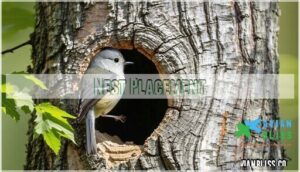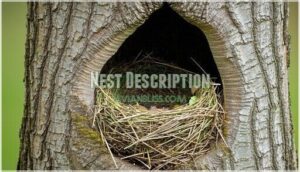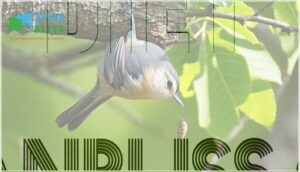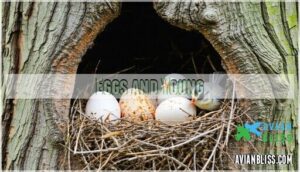This site is supported by our readers. We may earn a commission, at no cost to you, if you purchase through links.
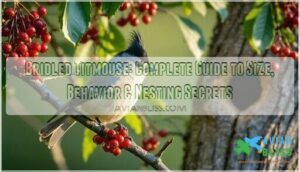
This small gray songbird measures 5-5.5 inches and inhabits oak and pine woodlands across the southwestern United States and Mexico.
They’re highly social, forming mixed flocks in winter while demonstrating remarkable acrobatic feeding skills as they search for insects, seeds, and berries.
These curious birds nest in tree cavities, laying 5-7 white eggs with reddish spots.
Their adaptable nature and striking appearance make them stand out among North America’s small songbirds.
Understanding their unique nesting habits and seasonal behaviors reveals fascinating survival strategies.
Table Of Contents
- Key Takeaways
- Size and Shape
- Color Pattern
- Behavior
- Habitat
- Nesting
- Diet
- Eggs and Young
- Conservation
- Frequently Asked Questions (FAQs)
- What is the bridled titmouse habitat?
- How rare is a Tufted Titmouse?
- What does it mean to be called a titmouse?
- Why is a titmouse called a titmouse?
- What is the difference between a Tufted Titmouse and a crested titmouse?
- Are titmice aggressive?
- What does it mean to see a Tufted Titmouse?
- What are the bridled titmouse’s vocalizations like?
- How do bridled titmice interact with other bird species?
- Are there any cultural significances of the bridled titmouse?
- Conclusion
Key Takeaways
- **You’ll identify bridled titmice by their distinctive black and white facial stripes that resemble a horse’s bridle, plus a prominent black crest they can raise or lower.
- **You’ll find these 5-inch gray songbirds in oak and pine woodlands across the southwestern US and Mexico, typically at elevations between 1,800-2,200 meters.
- **You’ll observe their acrobatic feeding behavior as they hang upside-down from branches searching for insects, seeds, and berries while forming social mixed-species flocks in winter.
- **You’ll discover they’re cavity nesters that lay 5-9 white eggs with reddish spots, often with helper adults assisting the breeding pair – a rare cooperative breeding system among North American titmice.
Size and Shape
When you spot a Bridled Titmouse, you’ll notice its compact yet elegant body proportions.
This sparrow-sized bird measures 4-5.25 inches in length with dense plumage density that helps it survive mountain climates.
Its most distinctive feature is the prominent black crest that can be raised or lowered, creating an expressive appearance that changes with the bird’s mood.
The crest size varies but remains consistently bold, while the small, cone-shaped bill morphology is perfectly adapted for extracting insects from bark crevices.
You’ll observe relatively broad wing shape proportions that enable agile maneuvering through dense oak woodlands.
The bird tail shape is proportionally long compared to its compact body, giving it excellent balance while foraging.
Bird size measurements show this species weighs just 0.4 ounces, making it North America’s smallest titmouse.
These physical characteristics work together to create a highly specialized mountain woodland forager.
Color Pattern
The Bridled Titmouse displays one of North America’s most distinctive head patterns.
You’ll immediately recognize the bold black and white bridle pattern that earned this species its name.
The gray and black crest stands prominently above striking facial markings that resemble a horse’s bridle.
Their bird color scheme features mostly gray plumage on the back and wings, with pale gray underparts.
Their sophisticated gray palette creates subtle elegance across woodland canopies.
The head pattern creates dramatic contrast – black stripes frame white cheeks and extend through the eye region.
Some individuals show subtle buffy tones on their underparts, adding warmth to their appearance.
- Plumage Variations: Regional differences exist but maintain the signature pattern
- Facial Markings: Bold black stripes create the distinctive "bridle" appearance
- Crest Coloration: Gray base with prominent black borders that can be raised or lowered
Sexual dimorphism remains minimal in this species – both males and females share identical markings and coloration, making field identification based on plumage alone nearly impossible.
Behavior
Beyond their striking appearance, you’ll find these birds are masters of Social Behavior and teamwork.
They form tight-knit family groups that stick together long after breeding season, creating impressive Flock Dynamics where everyone has a role.
Their Foraging Habits are acrobatic—you’ll watch them hang upside-down from branches like feathered gymnasts, probing bark crevices for hidden insects.
Vocal Communication keeps the group connected through constant chatter and contact calls.
During winter, they join mixed-species flocks, turning the forest into a bustling community.
Their Caching Behavior shows remarkable foresight—they store seeds and insects in bark crevices for leaner times.
Bird behavior studies reveal these patterns make them incredibly adaptable:
- Sentinel behavior where some birds watch for predators while others forage
- Dominance hierarchies that maintain order within winter flocks
- Allopreening sessions that strengthen social bonds through mutual grooming
Habitat
You’ll discover the bridled titmouse thrives in specific southwestern woodlands that offer perfect conditions for their year-round lifestyle. These remarkable birds show strong forest preferences for particular elevation ranges and habitat types.
These woodland specialists carve out their mountain niches with remarkable precision and flair.
Key habitat characteristics include:
- Oak and pine-oak woodlands at elevations between 1,800-2,200 meters, where mature trees provide abundant foraging opportunities
- Riparian zones with cottonwoods and sycamores that serve as essential refuges during drought conditions
- Mixed woodlands featuring Emory oak, Arizona white oak, and Chihuahua pine that support diverse insect communities
Seasonal shifts occur when birds descend to lower elevations during winter months. Their range spans from Arizona and New Mexico through Mexico’s Sierra Madre Occidental.
The birds are easily identifiable by their distinct facial markings. Habitat threats include logging, climate change, and drought, which force birds into remaining woodland corridors. Coexisting species like nuthatches and kinglets often join mixed flocks in these southwestern woodlands.
Nesting
You’ll find bridled titmice nesting in tree cavities from April through June, using old woodpecker holes or natural hollows they’ve claimed as their own.
These resourceful birds line their nests with soft materials like grass, animal hair, and spider webs, creating cozy homes 4 to 30 feet above ground in their oak and pine woodland territories, which are their woodland areas.
Nest Placement
When you’re searching for these birds’ nests, you’ll find them tucked away in woodland preference areas at varying elevations.
Their cavity selection process is quite particular—they choose both natural tree cavities and abandoned woodpecker holes.
You can also explore options for woodpecker nesting boxes.
- Nest height ranges from 4-30 feet above ground
- Nest cavities include natural holes and old woodpecker sites
- Nest box options provide alternative nesting opportunities
- Cooperative breeding sometimes involves helper adults assisting parents
Nest Description
Inside tree cavities, female Bridled Titmice craft cuplike nests using diverse materials.
These cavity-dwelling architects select Nest Materials carefully for ideal Nest Construction:
- Soft grasses – creating a cozy foundation
- Dried leaves – providing insulation and comfort
- Spider webs and animal hair – binding everything together
They may even incorporate specialized nesting grasses for added comfort.
The Nest Dimensions fit snugly within natural cavities or nest boxes.
Nesting Facts
You’ll find bridled titmouse nesting fascinating with their cooperative breeding system.
These birds select cavities 4-30 feet high, with female construction dominating nest building.
Their clutch size averages 5-9 eggs, requiring a 12-14 day incubation period.
What makes them special is their parental care system—often including helpful third adults.
They’re unique because they’re the only North American titmouse species with regular helpers, but other species like the Tufted Titmouse may cache seeds nearby.
Key nesting facts include:
- Nest building: Females line cavities with grass, leaves, and soft materials
- Incubation: Female-only duty while males provide food during nesting season
- Cooperative breeding: Helper adults assist with feeding, rare among North American titmice
Diet
After understanding their nesting behaviors, you’ll want to know what keeps these acrobatic birds so energetic. The Bridled Titmouse maintains an omnivorous diet that changes with the seasons, making their bird feeding habits fascinating to observe.
Insect consumption dominates their spring and summer menu, with caterpillars, beetles, and spiders providing essential protein. You’ll spot them performing impressive acrobatic moves – hanging upside down from branches to snatch insects from bark crevices and leaf undersides.
Their foraging habits are remarkably adaptable:
- Hopping actively through oak and pine branches seeking arthropod prey
- Gleaning insects from bark, leaves, and twigs using visual and tactile cues
- Consuming seeds and acorns during autumn and winter months
- Joining mixed-species flocks to enhance foraging efficiency
- Rarely practicing food caching, instead relying on continuous daily foraging
Seasonal foods shift their titmouse diet toward plant materials when insect populations decline, with oak acorns becoming particularly important winter sustenance. Consider using specialized insect feeders to supplement their diet.
Eggs and Young
When you observe Bridled Titmouse reproduction, you’ll notice their clutch size ranges from 5-9 eggs per breeding attempt. These oval white eggs, often speckled with reddish-brown at the larger end, require a 13-14 day incubation period handled exclusively by females.
Notably, other bird species, such as Blue Jays, lay eggs that feature unique speckled patterns for camouflage.
Parental care becomes a cooperative effort once chicks hatch:
- Female incubates while male provides food during the two-week incubation period
- Both parents engage in intensive feeding behavior, making over 35 visits per hour during peak demand
- Nesting continues with fecal sac removal and nest maintenance duties
Chick development follows a predictable pattern – hatchlings emerge naked and blind, opening their eyes by day 6-7. Full feather coverage appears around day 12, with fledging occurring at 16-18 days.
Fledgling success depends heavily on parental feeding for 2-3 weeks post-fledging, with juvenile survival rates around 55% during their critical first month.
Conservation
With growing pressure on their oak woodland homes, Bridled Titmice need your attention.
These birds currently hold "Least Concern" status, but several factors threaten their future stability.
Key conservation challenges include:
- Habitat Loss from residential development in mountain regions
- Climate Change altering montane forest conditions
- Fire suppression disrupting natural oak woodland cycles
- Invasive species affecting nesting sites
- Drought periods reducing food availability.
Population Trends remain stable across Protected Areas like national forests.
Conservation Efforts focus on maintaining cavity-rich habitats through controlled burns and invasive species removal, ensuring these charismatic birds continue thriving.
Frequently Asked Questions (FAQs)
What is the bridled titmouse habitat?
Like a hidden gem tucked in mountain pockets, you’ll discover this habitat in oak and pine woodlands across southwestern United States and northern Mexico at elevations between 1,800-2,200 meters.
How rare is a Tufted Titmouse?
Tufted Titmice aren’t rare at all—you’ll find them commonly throughout eastern North America. They’re year-round residents with stable populations, making them regular backyard visitors you can spot.
What does it mean to be called a titmouse?
Being called a "titmouse" simply means you’re named after these small, active songbirds known for their curious nature and acrobatic feeding habits.
The name combines "tit" (meaning small) with "mouse" (referencing their quick, darting movements through trees), which reflects their acrobatic abilities.
Why is a titmouse called a titmouse?
The name "titmouse" comes from Old English "titmase," where "tit" meant small and "mase" referred to a small bird.
You’re dealing with linguistic evolution that transformed over centuries into today’s familiar term.
What is the difference between a Tufted Titmouse and a crested titmouse?
While you might confuse them, the Tufted Titmouse sports a plain gray crest, whereas the Bridled Titmouse rocks distinctive black-and-white facial stripes resembling a horse’s bridle pattern.
Are titmice aggressive?
You won’t find titmice picking fights with other birds.
They’re generally peaceful, social creatures that prefer joining mixed flocks rather than defending territory aggressively.
During breeding season, they’ll defend nests but rarely engage in serious conflicts.
What does it mean to see a Tufted Titmouse?
Like a gentle whisper through forest leaves, spotting a Tufted Titmouse suggests you’re embracing curiosity and resourcefulness.
These acrobatic birds symbolize adaptability, social connection, and finding joy in life’s small discoveries while traversing challenges with grace.
What are the bridled titmouse’s vocalizations like?
You’ll hear their sharp whistles, chirrups, and calls echoing through oak woodlands.
These vocalizations help them communicate with flock members, defend territory, and coordinate during foraging activities throughout their mountainous habitat.
How do bridled titmice interact with other bird species?
Birds of a feather flock together," and you’ll spot bridled titmice joining mixed-species flocks with nuthatches, kinglets, and other small birds, foraging cooperatively while maintaining their social bonds throughout seasons.
Are there any cultural significances of the bridled titmouse?
You’ll find limited cultural significance specific to this species.
Unlike broader titmouse groups, you won’t discover significant folklore or mythology.
While they’re not known for any special cultural significance, these birds play a big role in their ecosystem.
They’re primarily valued for their ecological contributions.
Conclusion
Like a small acrobat performing in nature’s theater, the bridled titmouse captivates observers with its distinctive appearance and remarkable behaviors.
You’ve discovered how these adaptable birds thrive in southwestern woodlands through their social nature, cavity-nesting habits, and diverse diet.
Their striking facial patterns and energetic feeding displays make them unmistakable among songbirds.
Understanding the bridled titmouse’s unique characteristics helps you appreciate these resilient birds that successfully navigate seasonal challenges while maintaining stable populations across their range.
- https://www.birdorable.com/blog/meet-the-birdorable-bridled-titmouse
- https://en.wikipedia.org/wiki/Bridled_titmouse
- https://www.chuckramseyphotography.com/Birds-Everywhere/Songbird-Symphony/Chickadees-Allies/Chickadees-Allies-Family-Paridae/Chickadees-Allies-Genus-Baeolophus/i-BgkFMwz
- https://www.allaboutbirds.org/guide/Bridled_Titmouse/lifehistory
- https://www.sdakotabirds.com/species/bridled_titmouse_info.htm



